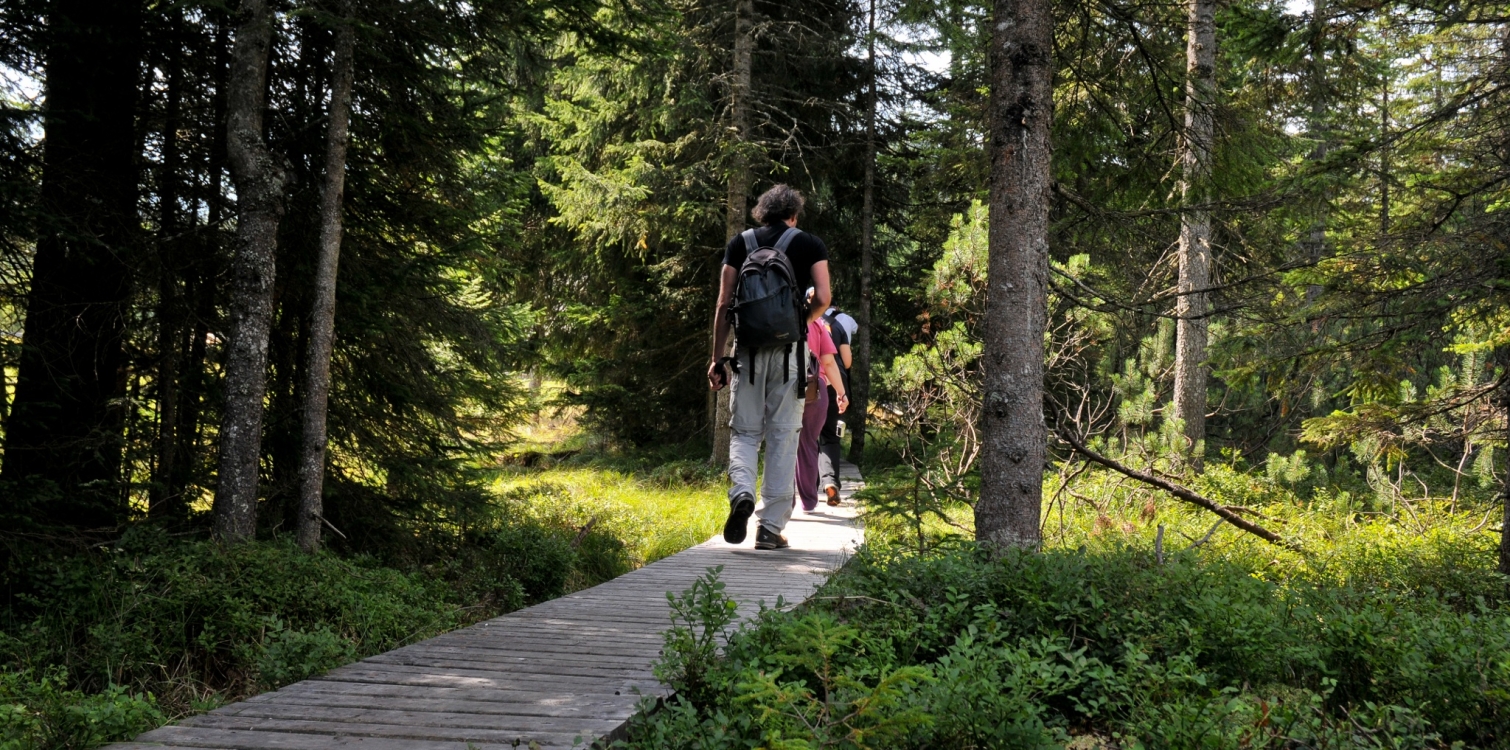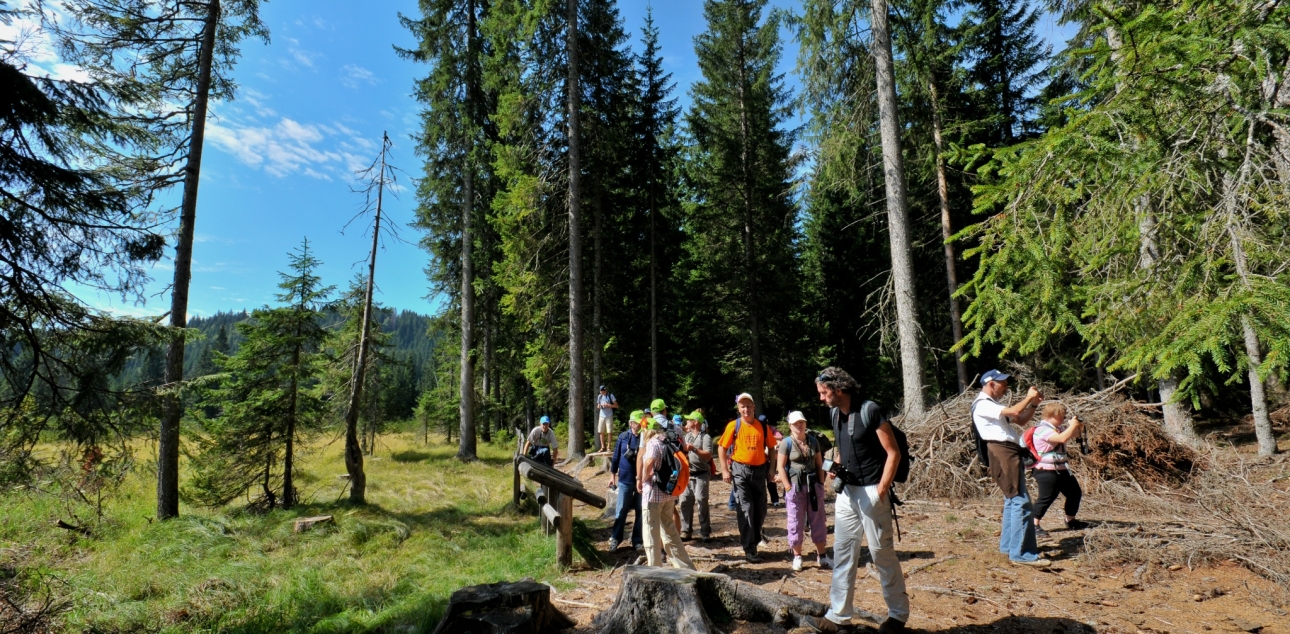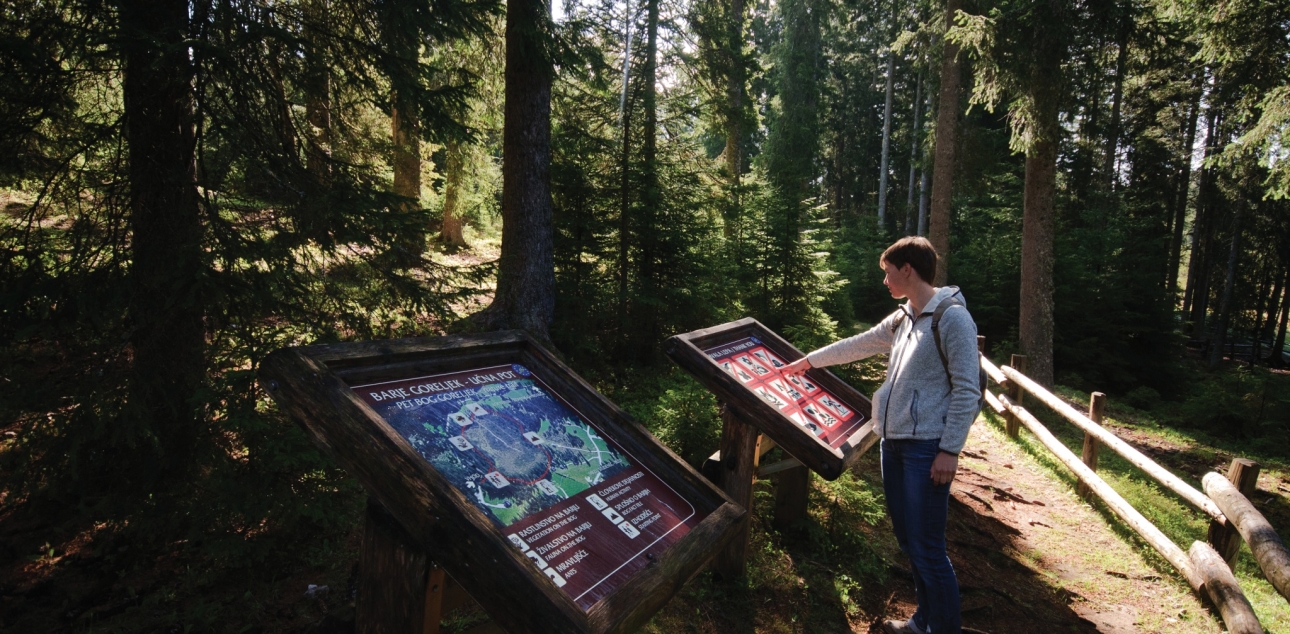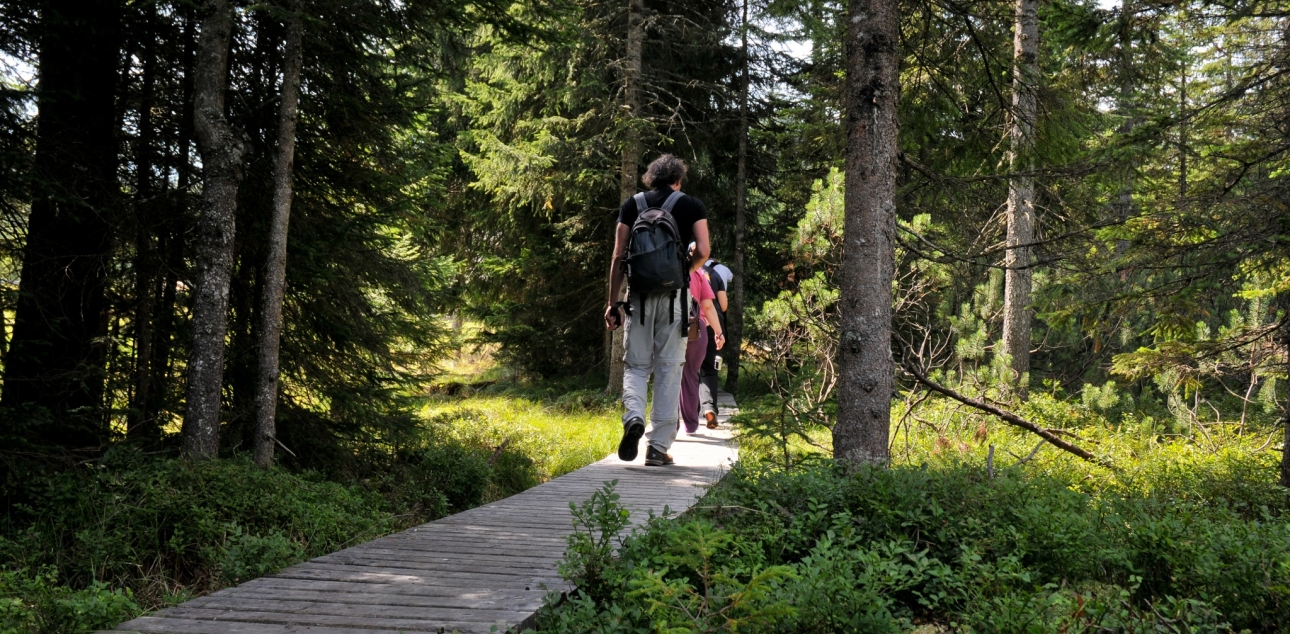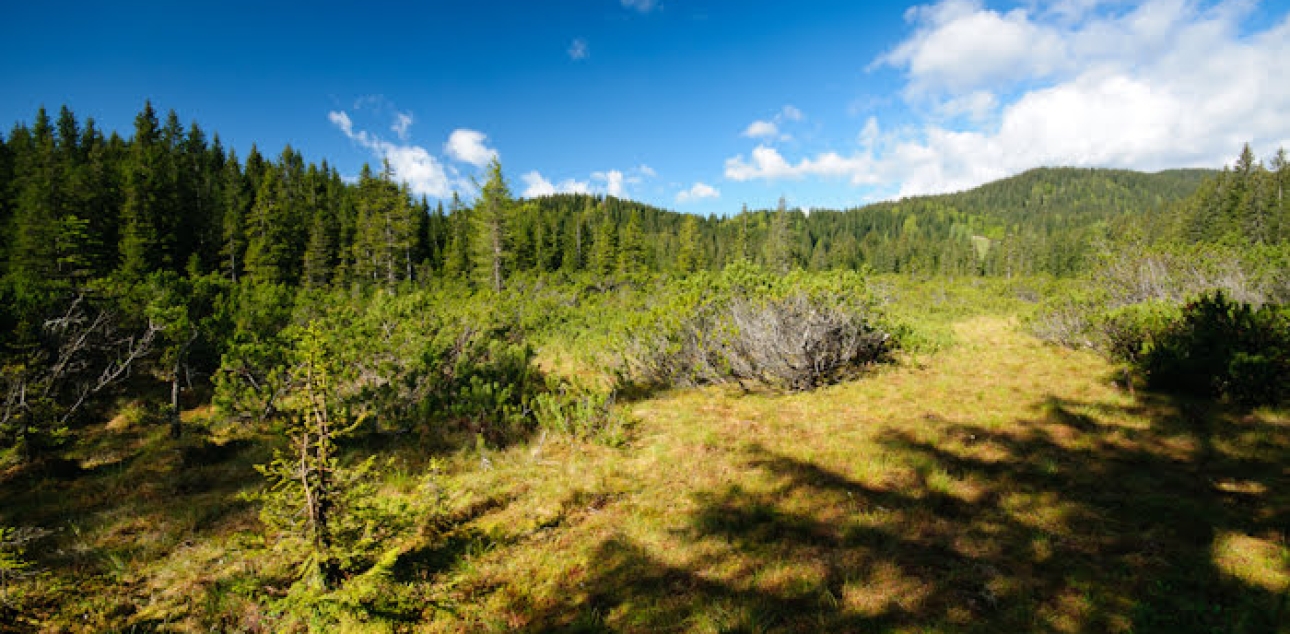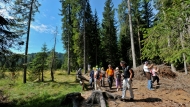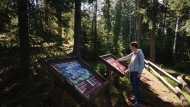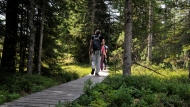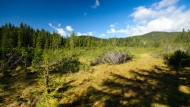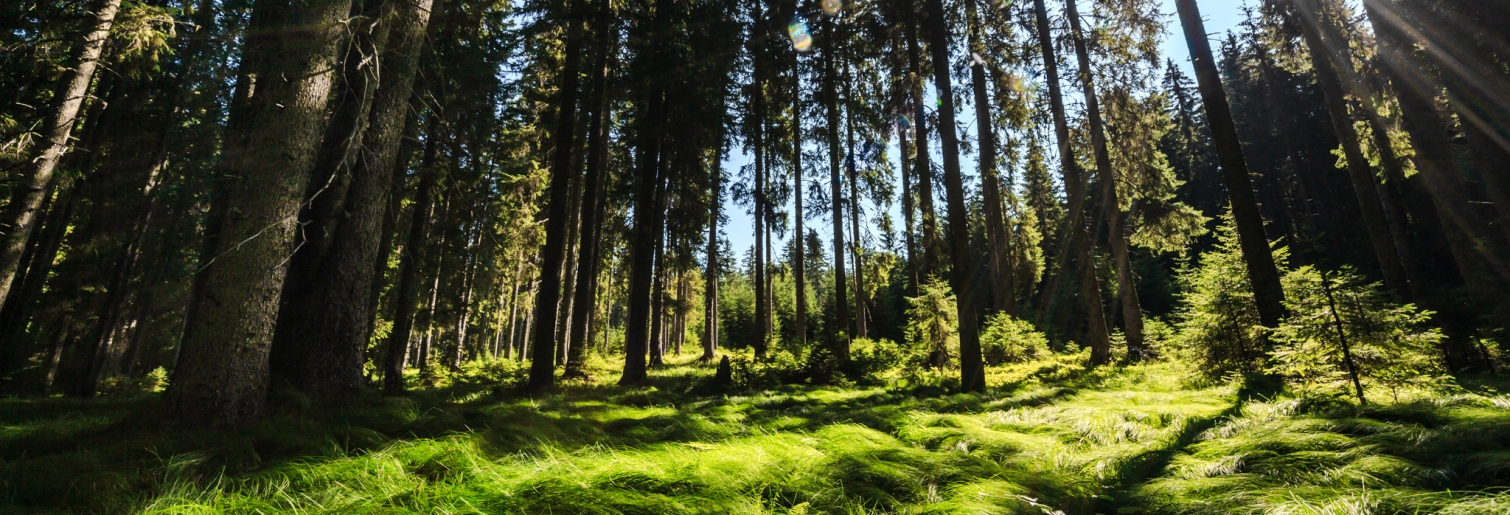You can reach starting point by public transport. Your station is (Pokljuka) Goreljek.
Find out more about sustainable mobility in the park and beyond.
An easy walk around Pokljuka's peat bog, one of the southernmost in Europe. On the information trail, you can learn about the flora and fauna of this sensitive habitat type.
The extensive spruce forests provide shelter for many species of flora and fauna, and the hikers enjoy peace and clean air. The Goreljek Trail is particularly interesting for learning about the special features and significance of peat bogs, which are among the most valuable nature areas in Europe. The trail is intended for all those who happen to visit Pokljuka, as well as for regular visitors, schoolchildren, school pupils and tourists alike.The Goreljek Moorland Trail is a nature trail that is designed to help visitors to the area learn more about the nature of the area.
Guided tours:
- by prior arrangement
- Phone.: 04 5780 205,
- Email: info.trb@tnp.gov.si
Peat bogs are areas of permanently standing water with a layer of peat a few decimetres or metres thick, overgrown with peat mosses. The process of bog formation started after the last glaciation. After the glacier retreated, small lakes were left behind. Over the millennia, they gradually filled up with various organic remains of aquatic plants that colonised the lake. The increasingly acidic water allowed only some plants to grow and develop. The most common were peat mosses, which still dominate the surface of the bog today. Peat mosses grow continuously at the top and turn charcoal at the bottom. The surface is thus rising, which is why these bogs are also called raised bogs.
Additional information
Difficulty of the route:
- short and easy trail, through the woods and along wooden footbridges along the moors
Points of interest along the way:
- more info points on the flora and fauna of the moor, Pokljuka today and in the past, the general characteristics of the moor and human activities in the surrounding area
Appropriate time of year:
- dry season
Visit payability:
- free of charge
Guest houses and mountain huts:
- Hotel Jelka
Recommendations:
- suitable hiking footwear
Trail Manager:
- Triglav National Park
A walk around the Goreljek peat bog
What is a peat bog?
An area of standing water, covered with a layer of peat ranging in size from several decimetres to several metres and overgrown with bog mosses is called a peat bog or a raised bog. The bog basin is separated by an impermeable layer from underground and surface water sources. Water and nutrients can only be transmitted through precipitation, air humidity, evaporation and surface outlets.

Formation of a peat bog
The formation process started after the last glaciation, where small lakes formed after retreat and then filled up over thousands of years with the organic remains of aquatic plants. The bog basin is separated from underground inflows by an impermeable layer and has no surface inflows. Mineral exchange takes place through precipitation, air moisture and evaporation. The bogs, due to the constant overgrowth of peat mosses, rise uphill in the central part, where a lenticular shape can be seen on the sketch.

Harsh conditions in the bog
Bogs are open and varied landscapes where humid depressions interchange with raised ground. In summer the bog area heats up during the day and cools down at night. Due to bog processes, the soil is acidic and poor in nutrients. Only highly adapted organisms can survive in this harsh environment.


Records from the past
The process of a glacial lake transforming into a bog lasts several thousand years. During that time, the lake basin is slowly filled with mud, sand and plant remains. Pollen is the most durable part of plants. It forms in a stamen, and from its form we can determine the plant species to which it belongs.
Since decomposition processes are not underway in the peat, pollen can be preserved for a very long time. The quantity of pollen in a peat layer tells us which were the predominating plants in a certain period of time.
Raised bogs in Slovenia
In Europe, raised bogs are common in Great Britain, Ireland, and Scandinavia while in Slovenia they are of rather rare occurrence. Well preserved bogs in Slovenia are on the Jelovica plateau, Pohorje and Olševa, as well as in the Ljubljansko barje and surrounding hillside. According to the latest data, there are only 20 preserved raised bogs in Slovenia, with a total surface of 150 ha.


Bog conservation
Bogs can be changed as a result of human activity or even destroyed through irrigation, peat exploitation, forest management, grazing, construction of infrastructure, recreation or tourism. The natural process of change in bogs is caused by drying and overgrowing, which will be further intensified as a result of climate change.,
Due to their exceptional, rare and threatened status, bogs are included in the list of habitat types of European importance. The entire area of raised bogs on Pokljuka is part of the Natura 2000 Network of Protected Areas.
Bog fauna
Peat bogs are permanently inhabited by only a few species of dragonflies, true bugs, butterflies, water beetles, bumblebees, ants and mosquitoes. The adder, bank vole and common shrew, viviparous lizard, grass snake, snape, bullfinch and tits live in dwarf pine stands. Other animal species are of only sporadic occurrence. Deer, mountain hare, fox and martens are representatives of large mammals.

A paradise for amphibians
In spring months amphibians flock to the bog from the nearby forests, drawn to small puddles where they lay their eggs. The life cycle of most amphibian species starts at the stage of larvae that breathe through gills to the stage of adult land animals that use lungs to breathe. Amphibians also breathe through skin, which must be wet at all times. The most frequent bog species are the common frog and the common toad.

Dragonflies
Dragonflies are undoubtedly the most typical animals of peat bogs. All great dragonflies are characterised by extremely high activity, especially on hot summer days. Their wings are held out flat even at rest. They often devour their prey while flying. Some species even mate in the air. A dragonfly spends most of its life in water as a larva, which is also an active hunter.

Bog flora
Peat bogs are characterised by low biodiversity. This means that it only takes a small number of organisms to maintain the life cycle and stability of the ecosystem. Stability, however, depends heavily on non-living factors, especially water, temperature differences, and nutrient supply.
Several species have developed the ability to trap and eat animals, others obtain nutrients through their partnership with fungi. In order to minimise water loss, some plants have developed a thick waxy leaf surface or an extensive root system. At the edge of the bog, where soil is richer in nutrients, other typical wetland species can also be found.

Carnivorous plants
Poor nutrient supply has led certain plants to develop organs for catching tiny animals, such as leaf adaptations. The bogs on Pokljuka are home to three carnivorous plants: sundew, bladderwort, and alpine butterwort.

Heather adaptations
Heathers are dwarf shrubs with waxy leaf surfaces. They are obligatorily associated with fungi living in their roots. The phenomenon called mycorrhiza enables plants and fungi to survive in soils which are occasionally dry and constantly poor in nutrients. In raised bogs, heathers can be found in slightly elevated and drier ground. In the Pokljuka bogs seven heather species can be found: common heather, blueberry, cowberry, bog rosemary, bog and small cranberry and bog bilberry.

Bog mosses
Bog mosses are the most important creators of peat bogs. This special group of mosses is perfectly adapted to extreme conditions. Chemical reactions in bog-moss cells which help the plant absorb water and nutrients cause high acidity of the area they inhabit.
The Pokljuka bogs are home to several moss species. The tops of peat hummocks are overgrown with mosses that can sustain long dry periods, whereas the mosses requiring more water grow near the water table. The moss carpet is a riot of colour because each moss has its own vivid hue.
Owing to their structure, bog mosses are extremely sensitive to mechanical impacts. Walking can cause severe erosion, resulting in patches of soil devoid of any vegetation

Mirna območja
Quiet zones are areas in Triglav National Park that play a key role in the conservation of plant and animal species. The quiet zones on the Pokljuka plateau are intended to promote protection of the western capercaillie, black grouse, and raised bogs. Since bogs are extremely sensitive areas, the only bog open to visitation and educational activities is the Goreljek bog. The Goreljek Bog Nature Trail has been set up to allow visitors to explore this interesting and rare habitat. You can also walk along the bog on the Mrzli Studenec nature trail.

